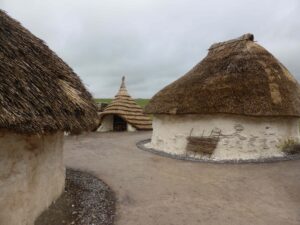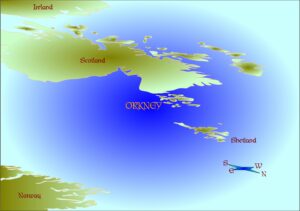I participated recently in a storytelling event organised by a project known as ‘Orkney Beside the Ocean of Time‘. They seek to investigate the relationships between the people of Orkney, Deep Time, and landscape change. For the event they invited half a dozen Orkney archaeologists to gather together and share a Continue reading Storytelling and Archaeology
Tag: communication
Guardian Newspaper helps archaeology to reach the parts that other papers ignore

The Guardian Newspaper is starting an archaeology and anthropology blog: Past and Curious. It is a great step forward for a newspaper which has always (to my mind) had a good reputation for measured, well-researched archaeology. It should be interesting. I’m hoping it is going to tell us more about the ways in which the past impacts on ordinary everyday lives, today and in the past, here and elsewhere, rather than about ‘tombs, treasures, tribes, and high adventure’, though. This is just because one of my bugbears is the way in which we reduce everything archaeological to hyperbole. To be fair they do suggest that they will be aiming to get behind the scenes and into the nooks and crannies of our work. Perhaps I’m also jealous that archaeological adventurer was not a career path when I graduated, and these guys seem to be taking full advantage of the possibilities that suggests. But then, if I reflect, I’d have to say that I’ve had my fair share of adventures: digging on the Lebanese border with Israel in the 1970s; trying out stone age technology in Lapland in the 1980s; working in the arctic; and in the far south.
It is certainly true that archaeology impacts on everyone, everywhere, in every field of life. So, I look forward to reading their blogs and seeing how they settle in. It is a great step forward, towards the infiltration of archaeology into all aspects of the twenty-first century.
Communication

It is just over a year since I started writing this blog. I’ve been thinking about why I am still writing.
Actually, it is quite addictive. I love writing, I like crafting language, and I particularly like the way in which the blog allows me to write without rigid boundaries. Of course, there are norms, both social and academic which I try to follow. These include adding links to sites that I might mention and, obviously, crediting and linking to other material. I don’t have to worry about house-styles, specifics of grammar, or content, because I’m not bound by publishers or referees.
It is wonderfully liberating to be able to jot down my thoughts on topics that matter to me. And amazing that anyone likes to read them. It gets me thinking and encourages me to research topics that I might normally gloss over. I enjoy the challenge of trying to craft something sensible and vaguely interesting in a relatively short space. Occasionally someone will comment on something and occasionally the blog has led me down completely new and interesting routes. It has all been fun and I don’t intend to stop. I was surprised by how stressed I got recently when poor broadband restricted my ability to communicate online.
There are so many different ways in which one can communicate. I’m no artist, and definitely not a musician. My contact with fiction writers has taught me that I could never write a novel. I love lecturing, but it is a more limited format. Many years ago I presented a radio programme on local archaeology: that was fun, but it was a lot more work than the blog. I spent a couple of days this summer working with a camera crew for the BBC – that was fun too, but I’m not sure I’m a natural; it is quite stressful trying to say the right thing with the right emphasis, enthusiasm, and facial expression. In academic writing I struggle to use the correct jargon. This is mainly because I hate jargon – if you are trying to communicate with the world, then it just seems lazy not to take the trouble to explain something in a way that everyone can understand. It seems I’m not alone in thinking like this, I have recently discovered the Rounded Globe publishing house which aims to produce freely available, jargon free, scholarly texts. If you have not visited their website – have a look.
I do love writing popular books and articles, but they can be time consuming and you are bound by the strictures of your editor and publishing house.
So, I’m left with the free-style blog.
I’m lucky to live in an era when internet technology not only allows me the means to reproduce my work for free, but also to export it around the world. If I have an overriding theme, it has to be the way in which the world of the past continues to touch on my own life. When I visit the Neolithic sites of Orkney I wonder about those who produced the carefully incised designs that one sees on so many of the stones at sites like Ness of Brodgar. Those who carved them, too, were communicating. Perhaps they loved it just as much as I do. We have long lost the lexicon and the grammar by which to understand their work. Maybe it was only ever intended for a few, maybe it was more general. Those who carved the Viking runes in Maeshowe seem to have thought that they would be understood by many. Those who produced the carefully illustrated Christian gospels knew that they would only be read by a few and that a ‘translator’ would be needed in order for their work to be appreciated by the general populace. I wonder how any of these people would feel were they to know that their communications are now the subject of study so many years later. Time, it seems, is the one element where my predecessors have the advantage of me. Somehow, I feel there is less chance that my ‘wisdom’ will be the subject of such interest in 3016.
The Power of the Periphery

There is a lot of discussion today about the power of the centre versus the power of the periphery. It is a question that transcends disciplines. In politics we see debate over the role of ordinary people in shaping both policy and institutions – there are numerous examples to be drawn from our own experience as in the Brexit vote, or the re-election of Jeremy Corbyn and we can also draw examples from the experience of others such as the continuing support for Donald Trump. Examples can be strategic and serious as in the events of the failed coup in Turkey, or more light-hearted and tactical, as in the debate (and eventual compromise) over the naming of a new polar research vessel: in this case it is the remote sub-sea vehicles that will bear the popular name of Boaty McBoatface. It occurs to me that people, us, are beginning to feel empowered as never before.
The old adage, ‘act local, think global’, is finally coming to fruition.
This is not just a matter of politics. It is something that affects many other aspects of our lives. One theme that came strongly out of the presentations and debates at CHAT2016, which I attended in Kirkwall recently (convenient), was the way in which communities are increasingly taking the lead in identifying the form and shape of their heritage. You might say that archaeologists have been keen for many years to involve local people in archaeology projects. And indeed this is so. Professionals have been working hard to give a voice to local people. But that is exactly my point. The difference today is that it is the people, not the professionals, who are leading the projects. The situation is no longer the rather patronizing one where we, as professionals, came into an area and identified ‘worthwhile projects’ with which people might like to become involved. Today, local groups are often in existence long before they bring in the archaeologists. In this way, and especially with regard to the archaeology and history of more recent years, we are beginning to create a record of the past that presents the view of those who experienced it, rather than those who have been trained to investigate it.
It is a new view of the professional: as facilitator, rather than instigator, but it is an exciting development. One in which our skills become truly worthwhile. There are numerous examples in other disciplines: self-publishing; pop-up cafes and shops; even Uber? Finally, the age of ‘Power to the People’ has arrived. I’m wondering why?
I’m wondering whether this is the real revolution of social media. The common use of Twitter, Facebook, Instagram, and all the other platforms has fostered an atmosphere in which we have all come to believe that we have authority. We recognise now that what we have to say is worthwhile. Social media, facilitated by broadband and 4G, allows our views to be shared, picked up, passed on, and enhanced. So, for the first time, we all have a voice that can travel. We have the power to organise. Of course, it has to be used with care, but it is a voice that increasingly, collectively, has power.
I’m not sure where this is leading us. There is something inherently unsettling about breaking away from the power of authority and I have a feeling that we may be in for some challenging developments. Our new world will, no doubt, require great powers of negotiation and compromise. Things may not always be done as we might like. But, in the long run, we will get used to things and I feel, I hope, that it will be positive. It is certainly bringing new and positive angles to our experiences of the past.
You must be logged in to post a comment.